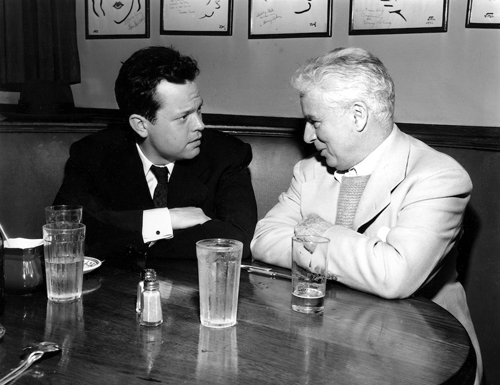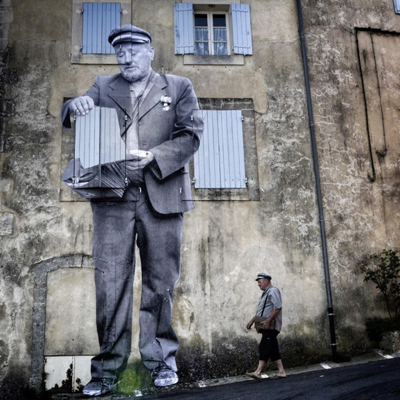Archive for July 2017
MONSIEUR VERDOUX: Lethal Lothario
DB here:
The newest installment of our Criterion Channel series on FilmStruck is now up. There I try to look at Chaplin’s Monsieur Verdoux (1947) from a fresh perspective: as a perverse contribution to the serial-killer cycle of the 1940s. You can sample it on the Criterion blog.
The killers inside them
When we say that we take up a new perspective on a film, or any artwork, what are we doing? I think the process involves at least two things. First, you need categories, some fresh conceptual groupings that allow for a perspective shift. Second, you relate the film in question to other particular films—that is, you pick prototypes of the categories. People don’t realize, I believe, the extent to which picking prototypes shapes our reasoning about nearly everything. (Is your prototype of a horror film Cat People, Halloween, or Saw? You’ll think of the genre differently.)
Take film noir. The category didn’t exist in 1940s Hollywood; no producer or director or writer set out to make a noir. A film might be a thriller, crime melodrama, even a horror movie. I discuss the elasticity of these categories here. When French, then American critics started talking about film noir, they were creating a perspective shift. The new category “film noir” pulled together several aspects of films that hadn’t seemed so salient in their day: skepticism about orthodox authority, for example, or suspicion of women’s sexuality. Similarly, the critics elevated certain films, like Double Indemnity and The Big Sleep and Possessed, to the status of prototypes, and less vivid examples were situated in relation to them.
Something like this perspective shift occurred to me when I was writing my book, Reinventing Hollywood: How 1940s Filmmakers Changed Movie Storytelling. I tried to come up with some categories that could show continuity and change in film narrative of the period. I looked for strategies of plotting and narration that cut across received categories like genre. Among the categories I explored are block construction, multiple-protagonist plots, subjective viewpoint, non-chronological story sequence, voice-over narration, and others. Some had come to be associated with certain genres (thanks again to prototypes), but I found that they were quite pervasive. Several of these I’ve tried out on the blog.
Once I was peering through the lenses of these categories, my prototypes changed too. Now little-discussed films like Our Town (1940) and Tales of Manhattan (1942) and The Human Comedy (1943) and The Chase (1946) became surprisingly central. I couldn’t ignore the classics, but they were now lit by a crosslight that brought out fresh aspects. And with these categories of narrative technique in mind, we can discover some new sides of well-known auteurs, like Welles, Hitchcock, Sturges, and Mankiewicz.
One broader category I tried out was that of “murder culture.” Mystery and suspense are perennial narrative appeals, but they took on new power in in fiction, film, and theatre of the Forties. (An early version of the chapter’s case is made here.) Part of murder culture was the rise of the serial-killer tale—not new in the 1940s, of course, but more common than in earlier Hollywood eras. Films like Shadow of a Doubt (1943), The Lodger (1944), Bluebeard (1944), Hangover Square (1945), Lured (1947), Follow Me Quietly (1949), and others became prototypes for my purposes.
Then Monsieur Verdoux appeared in a new light. What better evidence of the pervasiveness of murder culture than the effort by the most-loved film star in history to play a serial killer?
Landru in LA
Orson Welles and Charles Chaplin, Brown Derby restaurant, March 1947.
It was Orson Welles who prompted Chaplin to make Monsieur Verdoux. Welles was a thriller fan. He carried a trunkload of crime novels around on his travels. One of his early RKO projects was an adaptation of Nicholas Blake’s Smiler with a Knife, and after the debacle of It’s All True, his work as a freelance director consisted of thrillers (The Stranger, The Lady from Shanghai, Mr. Arkadin) and Shakespeare adaptations (Macbeth, Othello). Indeed, he treated Shakespeare’s plots as thrillers, in accord with his belief that the Bard wrote not classical tragedies but blood-and-thunder melodramas.
According to biographers, Welles wrote a screenplay based on the wife-murderer Landru and offered the role to Chaplin. Chaplin at first accepted, then decided to direct the film himself and bought the idea from Welles. There was apparently some dispute about giving Welles credit; early prints are said to have lacked acknowledgment of Welles’ idea as the source.
By late 1941, the trade press reported that Chaplin was preparing the film, then called “Lady Killer.” A year later, it was still discussed as a “plan.” Chaplin didn’t finish the screenplay until 1946, and the film was shot between May and September. By then it was entitled “A Comedy of Murders,” although Chaplin toyed with “Bluebeard” and “Bluebeard Rhapsody.” It wasn’t released until spring of 1947.
This long gestation period is significant because when Chaplin started, the idea of a comedy about killing would have been fairly fresh. By the time Verdoux was released, however, Arsenic and Old Lace (1944) and Murder, He Says (1945) had already shown that audiences would accept humor mixed with homicide. The original stage production of Arsenic and Old Lace had opened to great success in January of 1941, and it’s interesting to speculate that it might have encouraged Chaplin to buy Welles’ Landru idea.
Both Arsenic and Murder, He Says treat murder with a consistently farcical tone. I suggest in my FilmStruck Observations episode that Chaplin risks something more complex. For one thing, he takes the conventions of the serial-killer film more seriously than the other films do. He goes on to amplify and exaggerate those conventions in fascinating ways. For instance, he makes the policemen more or less stick figures, so we don’t care if they’re in jeopardy. In turn, Verdoux tries to win our allegiance through clumsy efforts to be debonair. (Uncle Charlie in Shadow of a Doubt is far more poised.) Chaplin’s use of the cycle’s conventions gets pretty specific. There were dead narrators in 40s films before Sunset Blvd. (1950), but we tend to forget that Chaplin uses the same device in Verdoux.
Going further, I discuss how Chaplin’s treatment of serial killing mixes different sorts of comedy—social satire and slapstick, the traditional comedy of manners and the comedy of ideas associated with George Bernard Shaw. This mix is rather discordant, and it’s responsible, I think, for much of the criticism the film attracted, then and now.
The Tramp as provocateur
Verdoux failed in the US for several reasons. Reviews were mostly unsympathetic, even harsh. Chaplin had been back in the headlines thanks to a messy paternity suit filed by Joan Barry. His reputation as a seducer of young women had unpleasant associations with Verdoux’s conquests. He was also known for his support for liberal causes and his strong stance against fascism. After the war, he was more and more reviled by right-wing politicians and activists. Chaplin’s defense of civil liberties made him seem too much a Communist dupe, or an active sympathizer. Charles Maland has suggested that the film’s promotion completely mishandled Chaplin’s star image.
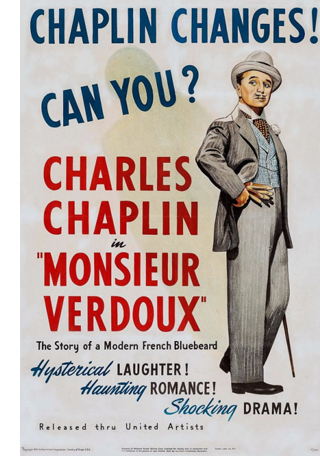 The disgraceful New York press conference on the film was chronicled in the New Republic:
The disgraceful New York press conference on the film was chronicled in the New Republic:
He couldn’t have expected the shockingly rude, sustained impertinence of the attack that followed. Reporters were there, not to discuss his work with him, but to discredit and vilify and ridicule him personally—to hound him on his own opinions and habits. Was it true that one of his good friends (I am omitting names), a great musician, was a radical? Did this mean that he, Chaplin, condoned treason to this country, since his friend’s brother was accused of being a spy? Was Chaplin a Communist? Why, then, had he shown so little regard for the United States that, although he had paid taxes here for years, he was still a British subject? Even though two of his sons fought for this country in the war, and he did war work himself, why didn’t he do more? Exactly what percentage of his vast income made in the US had gone to alleviate the suffering of humanity?
While two perambulating mikes broadcast these questions and others, a swarm of cameramen set off lights in Chaplin’s face, so that in an hour he was not only knee-deep in spent flash bulbs, but practically blinded. His patience and courtesy were astounding, since his disgust must have at least compared to that of the few of us who could only be ashamed of what ugly, hostile liberties can be taken in the name of the freedom of the press.
The final scenes of Verdoux only heightened the suspicion that Chaplin was a danger to patriotic values. Soon he was subpoenaed by the House Unamerican Activities Committee, though he never testified. In 1952, after he and his new wife Oona left for Europe, his re-entry permit was rescinded. He went into exile in Switzerland.
The reviewers’ most common complaint was that the film refused to jell, but the film had eloquent defenders and brought forth some of the subtlest critical commentary of the period. James Agee, the only person to defend Chaplin during the press conference, wrote a famous three-part appeciation of the film that, I think, represents an early instance of in-depth film interpretation. Theatre historian Eric Bentley argued against those who found the movie a jumble of sentiment and slapstick. It was, he claimed, in the vein of Pirandello, where comedy gives way to the more philosophical mode, that of humor.
Reflection turns the merely funny into humor. . . . Thus, Pirandello argues, humor breaks up the normal form by interruption, interpolation, digression, and decomposition; and the critics complain of lack of unity in all humorous works from Don Quixote to Tristram Shandy—and we might add from Little Dorrit to Monsieur Verdoux.
Going still wilder, Parker Tyler speculated that in a parallel universe, Verdoux wasn’t executed. He abandoned his wife and son and took off on the road. Charlie the Tramp “had a past like anyone else. . . . Verdoux is . . . how Charlie came to be.”
Tyler’s flight of fancy isn’t surprising. This film can drive you a little nuts. It’s not ingratiating. It’s less perfect than provocative. It’s like the name itself, ver-doux, which translates as “sweet worm” or “gentle worm”—a little pleasant and a little creepy. The film is an obstinate thing that insists on being its contradictory self, not what you want it to be. For me, it’s perversely unlovable, and that unlovability is part of the Chaplin myth too. We should remember that the earliest Chaplin films show the Tramp as fairly nasty.
I suspect that Monsieur Verdoux can’t become a prototype; it flouts too many cherished categories. Or maybe the best category for it is that of experimental Hollywood movie. After all, the 1940s furnished more than its share of them.
Thanks as usual to Kim Hendrickson, Grant Delin, and Peter Becker of Criterion. Our complete Observations on Film Art Criterion series is here. (I think you need to be logged in to see it.)
Welles discusses Shakespeare as blood-and-thunder melodramatist in This Is Orson Welles (HarperCollins, 1992), 217, and in a little more detail, in audiocassette number 4 accompanying the book, side A, 18:37. I draw my information about the preparation of Verdoux from Frank Brady, Citizen Welles (Scribners, 1989), 416-417; “Chaplin Announces Bluebeard Film,” Motion Picture Herald (29 November 1941); and Glenn Mitchell, The Chaplin Encyclopedia (Batsford, 1997), 191-198. Charles Maland’s reflections on Verdoux‘s promotional problems are in Chaplin and American Culture: The Evolution of a Star Image (Princeton, 1989), 250-251. The coverage of the Monsieur Verdoux press conference is by Shirley O’Hara in “Chaplin and Hemingway,” New Republic (15 May 1947), 39. Bentley’s 1948 essay is “Monsieur Verdoux and Theater,” In Search of Theater (Vintage, 1953), 154.
I’ve argued in The Rhapsodes that Agee’s critique displays the interpretive techniques borrowed from literary New Criticism. In the same book I discuss Tyler’s Chaplin book as an ultimate flight of performative criticism. One consequence of 1940s murder culture was the crystallization of the suspense thriller, a genre that has flourished ever since, for several reasons.
There’s more on my forthcoming book on the 1940s here.
Monsieur Verdoux.
Books not so briefly noted
“What a piece of junk!” Star Wars: Episode IV–A New Hope.
DB here:
Over there, across the room, a stack of more or less recently published books has haunted me for months. I wanted to tell you about them. True, I had plenty of excuses: My stay in Washington, a health nuisance, our trip to Bologna’s Cinema Ritrovato, and our looming deadline for a new edition of Film History: An Introduction. But excuses aren’t necessarily good reasons. My delay was especially painful because the books were by friends.
So here’s some penance. As usual, some of the books I’ve read completely; others I’ve read only stretches of. But each is on a fascinating subject, by people of sound mind and impeccable character–in other words, exceptional researchers, thinkers, and writers.
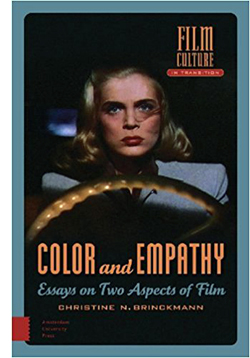 Christine N. (Noll) Brinckmann is both a critic and a filmmaker. In Color and Empathy, she brings hands-on expertise to two subjects too often ignored. Her essays treat the handling of color in silent cinema, 1950s Hollywood, experimental film, and Claire Denis’s Beau Travail. On the empathy side, she analyzes its role in documentary, Hitchcock films, and Eric de Kuyper’s Casta Diva.
Christine N. (Noll) Brinckmann is both a critic and a filmmaker. In Color and Empathy, she brings hands-on expertise to two subjects too often ignored. Her essays treat the handling of color in silent cinema, 1950s Hollywood, experimental film, and Claire Denis’s Beau Travail. On the empathy side, she analyzes its role in documentary, Hitchcock films, and Eric de Kuyper’s Casta Diva.
Noll is very good on what I’d call the “historical poetics” of color, starting from perceptual and technical aspects and moving to the ways conventions emerged historically. For example, she contrasts Pal Joey and Chungking Express: sharp-edged versus blurred, object colors versus ambient colors, narratively motivated color clusters versus poetic and associational ones. She introduces the useful concept of color “chords,” mingled hues that create motifs that weave through the film. With this concept she’s able to treat late 1950s Hollywood color comedies as having a “mannerist” style, with chords dissolving into moments of patches of pure abstraction. She finds this strategy in some very unexpected places; I never thought I’d need to look at Bob Hope’s Bachelor in Paradise again, but now it’s a must.
As a filmmaker, Noll is also sensitive to the bodily reactions of viewers. Empathy is one such general phenomenon. What I appreciated in her discussion was her eagerness to go beyond the usual sense of the term, which involves feeling for characters in an emotional register. By analyzing passages in Secret Agent and Frenzy, she also considers how visceral factors like motor mimicry play into our responses. She takes the face as the main arena of empathy, but gestures–like cracking open fingers closed in death–are central as well. Thanks to empathy, she notes, films align us with some fairly unpleasant people. “We have not invested any sympathy in the characters; we disapprove of their actions, yet wish them to succeed.”
As a filmmaker, Noll understands that films are made not with themes but with images and sounds, so her account of bodily engagement, like her analyses of color dynamics, is pervaded by the recognition that first of all a movie is a concrete experience engaging our senses and our minds. The critic can point to abstract meanings, but we’re also interested in the mechanics underlying those meanings, how movies arouse our appetites for action and emotion.
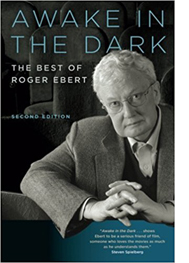
Two critics attuned to the many levels of a film’s appeals are represented in new collections. There’s now a second edition of Roger Ebert‘s Awake in the Dark: The Best of Roger Ebert, from the University of Chicago Press. The 2006 original, which contained his personal choice of his strongest reviews and essays through 2005, has been enhanced with new pieces on Roger’s favorite films from the years 2006-2012, the year before his death. Films covered are Pan’s Labyrinth, Juno, The Social Network, A Separation, and Argo, along with shorter notices on many more.
It’s clear that Roger’s abilities were undiminished despite his illness. As ever, he brings his own variety of empathy to the characters and story worlds displayed. His eye stayed sharp:”Del Toro moves between many of these scenes with a moving foreground wipe–an area of darkness, or a wall, or a tree. . .. The technique insists that his two worlds are not intercut, but live in edges of the same frame.” The dozens of pieces in the collection are full of warm, sensitive moments of appreciation. I have updated my introduction to add some further reflections on Roger’s legacy.
While Roger Ebert was starting his career in Chicago with a review of Bonnie and Clyde in 1967, Joseph McBride was at the University of Wisconsin–Madison, writing his own film criticism and working on his still valuable book on Orson Welles. A prodigy, yes. He moved to California the same year Kristin and I came to Wisconsin; we met him once, as I remember, just before he was about to leave. We’re kindred spirits, born sixteen days apart and bound by Boomer Auteurism.
Joe’s most famous screenplay is for Rock ‘n’ Roll High School, but he also scripted many of the AFI tributes. He’s a professional journalist and currently a university professor. But he is at bottom, as he readily admits, a book writer. His biographies of Capra, Spielberg, and Ford have become indispensable, while his memoir and analysis of Welles’ late career (What Ever Happened to Orson Welles?) is just as meticulously researched and intellectually ambitious.
Now Joe has given us a massive collection of his shorter pieces. Two Cheers for Hollywood, its ambivalent title echoing E. M. Forster’s Two Cheers for Democracy, includes a vast panorama of work. Journalist Joe, who has done over 15,000 interviews in his career, gives us a tempting sample here. He records encounters with screenwriters (Polonsky, Michael Wilson, Marguerite Roberts et al.) and directors (from Cukor and Wilder to Bernds, of Three Stooges fame). He talks with Stepin Fetchit in a Madison strip club and Peter O’Toole in the Beverly Wilshire (“his bony white hands and feet protruding from his royal purple robe like the wings of a great pale bird”). Saul Zaentz complains of “pseudo-stars” and Billy Wilder shows Walter Matthau how to rip out a phone cord in two jerks: “Zis is the first one, and the second zis is a ZUMP!” Each interview is prefaced by a thoughtful reflection on Joe’s own evolution as a writer.
Then there are the critical pieces, many of them magnificent. There’s the most detailed defense I’ve ever seen of the Coens, a nuanced investigation of Ford’s attitudes on race, a predictably acute account of Spielberg’s strengths and weaknesses, an appreciation of performance in Fahrenheit 451, a probing of Wild River (Kazan’s most Fordian film, methinks), and much, much more. The book contains 56 essays, all substantial. It runs to over 650 big pages. It lacks neither passion nor precision, just an index.
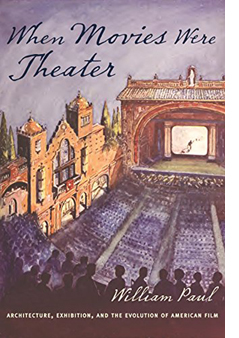 Another Boomer Auteurist is William Paul. Bill did some film reviewing in his younger days but became an academic like Noll and Joe and me. Currently Professor of Film and Media Studies at Washington University of St. Louis, he has written fine books on Lubitsch’s American films and on the tie between modern horror and modern comedy. What has consumed him in recent years is an in-depth investigation of the history of the movie house. When Movies Were Theater: Architecture, Exhibition, and the Evolution of American Film is the result, and it’s a landmark study.
Another Boomer Auteurist is William Paul. Bill did some film reviewing in his younger days but became an academic like Noll and Joe and me. Currently Professor of Film and Media Studies at Washington University of St. Louis, he has written fine books on Lubitsch’s American films and on the tie between modern horror and modern comedy. What has consumed him in recent years is an in-depth investigation of the history of the movie house. When Movies Were Theater: Architecture, Exhibition, and the Evolution of American Film is the result, and it’s a landmark study.
The broad historical arc moves, as you’d expect, from storefront theaters to picture palaces and then drive-ins and arthouses. But this is no simple account of buildings. Bill argues that the manner of presentation shaped the rise of the feature film, the recurring strategy of roadshows, the demands for double bills, and other factors of film form and industry conduct.
Bill suggests that the 1910s demand for “life-size figures” in film might have been a response to theater size, and he speculates that the move to closer shots in the 1920s might reflect enlarging venues. Makes you wonder if “intensified continuity” of the 1960s and thereafter owes something not only to TV as the ultimate destination of the images but also to the cramped screens of early “twinned” houses, those sticky-floored abominations.
As usually happens when a good historian dives deep, you get surprises. Bill uncovers floor plans with seats facing in the wrong directions, horseshoe-shaped venues, auditoriums packed with pillars, and other peculiarities. One counterintuitive thing that I learned was that screens were rather small for most of film history. A screen for a palace seating a thousand people might be only twenty feet across. Bill’s frames from Footlight Parade and Saboteur show views from the back of a playhouse, and they indicate that often the proscenium area wasn’t filled by the screen, which was cloaked in black masking.
The Hitchcock is of course a studio reconstruction of Radio City Music Hall, but Bill indicates that the proportions are accurate. In all, his When Movies Were Theater joins Douglas Gomery’s Shared Pleasures in showing, in sharp detail, just how varied and diverse American movie exhibition has been.
 I would recommend Steven Rybin‘s anthology The Cinema of Hal Hartley: Flirting with Formalism even if I didn’t have a piece in it. For one thing, I too flirt with formalism. Hell, I nearly eloped with it. Second, my study of staging in Simple Men is pretty bare-bones compared to the rich and varied work on display in the other essays in the book. Steve has written widely on American film, both classic and contemporary (Malick, Mann). His introduction to the book ranges across a vast terrain, from models of independent film to debates about “smart cinema.”
I would recommend Steven Rybin‘s anthology The Cinema of Hal Hartley: Flirting with Formalism even if I didn’t have a piece in it. For one thing, I too flirt with formalism. Hell, I nearly eloped with it. Second, my study of staging in Simple Men is pretty bare-bones compared to the rich and varied work on display in the other essays in the book. Steve has written widely on American film, both classic and contemporary (Malick, Mann). His introduction to the book ranges across a vast terrain, from models of independent film to debates about “smart cinema.”
The essays that follow offer agreeably intricate analyses of Hartley as a romantic comedy director, of “small films,” of Parker Posey as a muse, and on the Henry Fool trilogy as centered on the implications of writing. I especially appreciated the way that all the contributors (Mark L. Berrettini, Jason David Scott, Steven Rawle, Sebastian Manley, Daniel Varndell, Fernando Gabriel Pagnoni Berns, Zachary Tavlin, and Jennifer O’Meara) show how Hartley’s authorial obsessions responded to conditions of production, industry pressures, or critical reception. It’s called context, and yields a body of criticism that does honor to a director still not as fully appreciated as he deserves to be.
Another thick context, Wisconsin-revisionist style, is on display in Bradley Schauer‘s Escape Velocity: American Science Fiction Film, 1950-1982. In working on my book on 1940s cinema, I was struck by the absence of today’s dominant genres: fantasy and science fiction. SF books and magazines became widely popular in the period but, apart from cheap serials, the genre had a delayed arrival on movie screens. When it did arrive, Brad explains, it was presented not as classic space opera but something else, what he calls “topical exploitation cinema.”
 To escape the pulp associations of Flash Gordon, SF movies traded on current scientific discoveries and headline items like flying saucers. As often happens, it took a marginal player to push a new cycle. Eagle-Lion’s Destination Moon (1950) caught the attention of big studios, which embarked on mid-budget items like When Worlds Collide and The Day the Earth Stood Still (both 1951). Brad traces the cycle’s urge for legitimacy through special effects, more sophisticated narratives, and even appeal to Scripture. These developments were shaped by broader changes in the American film industry, especially concerning budgets and program policy.
To escape the pulp associations of Flash Gordon, SF movies traded on current scientific discoveries and headline items like flying saucers. As often happens, it took a marginal player to push a new cycle. Eagle-Lion’s Destination Moon (1950) caught the attention of big studios, which embarked on mid-budget items like When Worlds Collide and The Day the Earth Stood Still (both 1951). Brad traces the cycle’s urge for legitimacy through special effects, more sophisticated narratives, and even appeal to Scripture. These developments were shaped by broader changes in the American film industry, especially concerning budgets and program policy.
After spelling out this early history, Brad takes us through familiar titles from 2001 to Star Wars: Episode IV–A New Hope, but always fleshing out the story with new information and ideas. He shows that Kubrick gave his film prestige through art-cinema style and storytelling, while Lucas’s film gained traction by treating space-opera formulas with earnestness and respect rather than camp condescension. Brad analyzes important SF films that are often forgotten, like Logan’s Run and Rollerball. His discussion of Alien and Planet of the Apes reminds us that the current incarnations of these franchises have strayed somewhat from their original entries.
Again, the historian unearths surprises. Given the revulsion of today’s intellectuals toward Star Wars, which gets blamed for ushering in the Big Dumb Movie, it’s worth remembering that nearly all the critics praised it. Under the rubric “Fun in Space,” Newsweek‘s reviewer noted: “I loved Star Wars and so will you, unless you’re. . . oh well, I hope you’re not.” That’s sort of the way I feel about these books.
Earlier book-dedicated blog entries are here.
Designing Woman (1957): “There are three pillows stacked on each side of the sofa, and as if by chance they take up the colors of the party: red, turquoise, bluish-purple. . . . The color chord of the party becomes an end in itself, and the composition obtains a playful intrinsic value” (Christine Brinckmann, Color and Empathy, p. 48).
We do film, dammit: Charlie Keil interviews us
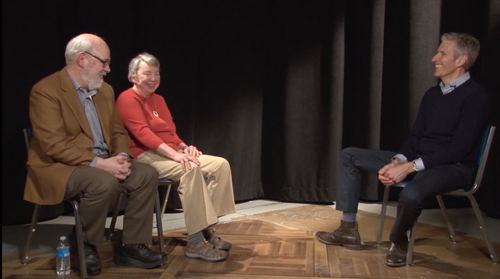
DB here:
The Society of Cinema and Media Studies has established an online series of interviews with film scholars. In these conversations, distinguished contributors to academic film history, theory, and criticism review their careers and sum up their main ideas.
Thanks to Charlie Keil’s initiative, we participated in one such session here at Madison, back in May. The result is here.
Under Charlie’s guidance we discuss how we got interested in studying film, how we conceived and wrote Film Art: An Introduction, and how we developed later research projects, including The Classical Hollywood Cinema, Narration in the Fiction Film, Breaking the Glass Armor, Making Meaning, The Frodo Franchise, and other books.
We talk about “neoformalism” and its relation to continental structuralism, as well as strategies of film analysis, the importance of norms, the roles of institutions in shaping film history, and cognitive film theory. We touch on the history of Wisconsin film studies and the central role of Tino Balio, Douglas Gomery, and Janet Staiger in shaping our thinking. We also talk about “overachieving” textbooks and our efforts to reach out beyond academic readers, especially via the Net.
Charlie skillfully fits what we tried to do into broader trends in academic film studies. He highlights our frequent returns to studying Hollywood as an artistic and industrial reference point. He even brings up Kristin’s Egyptological research.
There wasn’t enough time to survey all our interests, of course. There’s probably too little on our most recent work; if you want to dig more into our ideas, the published work and our writing on the blog are more informative. And there aren’t enough jokes, at least deliberate ones. Still, we hope some of you will find this discussion of interest.
Thanks not only to Charlie Keil and the SCMS people coordinating the Fieldnotes series, but also to Madison’s own Eric Hoyt, Chelsea McCracken, and Erica Moulton for shooting the interview.
Ritrovato 2017: Many faces, many places
Agnès Varda and JR, Il Cinema Ritrovato, 1 July. Photo: DB.
DB here:
This final post from Il Cinema Ritrovato is no less a miscellany than the others. With over 500 films screened, Kristin and I invariably missed things that others raved about. Still, we saw enough powerful cinema to make us want to flag some key items for you.
Silents, please
Kristin has already mentioned one of the most startling items we saw, Le Coupable (1917) by André Antoine. I’m still processing the audacity of this film. The prosecutor in a murder trial abruptly claims the defendant as his son. We then get the familiar flashback format, shifting from the courtroom to the events leading up to the crime and the arrest. But the shifts between present and past are so quick, and the bits we see of the trial are given in such intense, stark singles, that they gain an astonishingly modern pulse.
Add in marvelous use of locations, real alleys and corridors and cafes, and you have a very impressive movie.
Once more, 1917 proves to be dynamite.
From the same year came Furcht (Fear), by Robert Wiene. Count Grevin wanders anxiously through his castle for about sixteen minutes of screen time before we realize, thanks to a flashback, that he’s haunted by his theft of a precious Indian statue, stolen from a temple. Soon a priest materializes, either on the castle grounds or in Grevin’s imagination, to declare that he has only seven years to enjoy life before vengeance strikes. Which it does, of course. Conrad Veidt plays the priest with the smoldering glare, and ambitious superimpositions show how committed German cinema was to special effects. Dr. Caligari was three years off.
 Not that other years should be slighted. Le Collier de la danseuse (The Dancer’s Necklace, 1912) was an agreeably preposterous crime movie. (The thief has a jacket with fake hands dangling from the sleeves, just the thing for escaping handcuffs.) The film boasted the low, almost Ozuesque, camera height typical of other Pathé productions of the year.
Not that other years should be slighted. Le Collier de la danseuse (The Dancer’s Necklace, 1912) was an agreeably preposterous crime movie. (The thief has a jacket with fake hands dangling from the sleeves, just the thing for escaping handcuffs.) The film boasted the low, almost Ozuesque, camera height typical of other Pathé productions of the year.
Borzage’s Secrets (1924) traces a marriage through three large flashbacks, with the first emphasizing romantic comedy, the second suspense, and the third family melodrama. Norma Talmadge, who savored a split-personality role in De Luxe Annie (1918), gets to play a woman at three ages here. The central section, devoted to a Griffithian siege on a lonely frontier cabin, showed Borzage’s ability to whip up enormous excitement, with an unexpectedly sad twist. The whole movie has over 11oo shots, indicating just how committed American filmmakers had become to fine-grained scene breakdowns.
All in all, the silent films on display this year were as revelatory as ever.
Cinematic geometries
The Abe Clan (1938).
For some years Ritrovato has included a Japanese sidebar curated by Alexander Jacoby and Johan Nordström. This year the theme was socially critical jidai-geki, or historical films. Some of them were fairly familiar to Western cinephiles because copies were circulated by the Japan Film Library Council from the 1970s onward. Examples include The Abe Clan (1938) and Fallen Blossoms (1938), both very good films. Along with these, the Bologna series gave the Yamanaka Sadao classic Humanity and Paper Balloons (1937) another well-deserved airing.
Some of these are fairly intimate dramas, others use a lot of spectacle. The image from Abe Clan above is fairly typical of the monumental turn some jidai-geki took in the late 1930s. Several of the films starred members of the left-wing Zenshinza kabuki troupe, perhaps best known to aficionados from Mizoguchi’s staggering Genroku Chushingura (1941-1942).
Three of the other films showed the range of this genre during Japan’s “dark valley,” its turn to authoritarian rule and imperial warfare. The Rise of Bandits (1937), by Takizawa Eisuke, was a rousing but melancholy Robin Hood tale. A lord’s honest son tries to save a shipment of gold from marauders, but he’s framed by his duplicitous brother. So he becomes the outlaws’ leader, at the cost of his wife’s life and his father’s trust. Some superb action sequences, including a fiery final assault on the castle, alternate with semicomic scenes among the bandits, with the hero’s cynical sidekick twisting not-too-bright thugs around his finger.
Hagiwara Ryo’s The Night Before (1939, production still above) was based on a Yamanaka script, and like Humanity and Paper Balloons, it braids together several characters’ fates. As rival samurai factions struggle during the Meiji restoration, ordinary people–an artist, a family running an inn, a young man wanting to make his name as a warrior, a bitter and disenchanted samurai–try to get by. One of the innkeeper’s daughters is attracted to the youth, another daughter who works as a geisha eyes the artist, and the old man seems to escape into endless games of shogi with a neighbor. The film has a panic-stricken climax, in which the factions collide in darkness along the riverside and innocents get swept up in the violence. As with many films in the series, the critique of mindless militarism isn’t far below the surface.
The Man Who Disappeared Yesterday (1941), by the great Masahiro Makino, is a murder mystery. An unpleasant landlord is the victim, and there are plenty of suspects. The scattered clues didn’t seem to me to play entirely fair, but the investigation is largely a pretext to explore adjacent households and obfuscate what turns out to be complicated post-murder maneuvers. At the climax, all the suspects are seated in a single line to hear the magistrate’s solution, just as if they were in Nero Wolfe’s office.
Makino’s style accentuates the spatial layout through a remarkable ten zoom-ins that yank us to one or another suspect as the explanation is given, sometimes with flashbacks. Camera zooms (as opposed to optical-printer ones, as in Citizen Kane) are rare in any national cinema of this period, and Makino uses them almost in the spirit of Hong Sangsoo, more to perk up our attention than to enlarge anything for closer scrutiny. (Admittedly, the last one rivets us on the guilty party.) The same geometrical impulse encloses the tale: an opening crane shot down, a closing one upward. As often in Japanese cinema, The Man Who Disappeared Yesterday marks and repeats film techniques to give a decorative flourish to the story.
Technique also comes to the fore, of course, in Divine (1935), a French production directed by Max Ophüls. The attraction isn’t just the dizzying camera movements, swimming through a tangle of backstage paraphernalia and crawling up stairways. Max is more than a master of the tracking shot. In one witty passage, framing and cutting coordinate to stretch the distance between a couple who can’t tear themselves away from each other. (In my last frame, the milkman’s head slides almost out of frame.)
The plot centers on a country girl who becomes a follies performer and is framed as a drug dealer by a Lothario and a lesbian. This contraption seems more or less a pretext for Ophüls to indulge his endless fascination with women striking poses for men while asserting their own demands. The abrupt and unexplained happy ending is the logical wrapup for a film less concerned with a plausible plot than a display of Woman in all her dazzling divinity. There. How’s that for a Sarris sentence?
Bigger than life
Although there were some repeats on Sunday, the final big event of the festival was the screening, to some 3000 people on the Piazza Maggiore, of the new film by Agnès Varda and JR. Kelley Conway reviewed its Cannes premiere for us earlier, and now that we’ve seen it, we like it a lot.
Varda has the ability to take a whimsical, borderline-cutesy idea and turn it into something poignant, as in Daguerreotypes and Opéra-mouffe. (Nursery-rhyming titles, like Mur Murs and Sans toit ni loi, encapsulate her attitude.) Her latest, an associational documentary along the lines of The Gleaners and I, depends on the premise of traveling through France and making enormous photographic portraits of ordinary people. These are then mounted on buildings in their home town–hence the title Visages Villages.
The result is both intimate and monumental. A postal clerk or a woman truck driver take on the billboard proportions of politicians and pop stars. Without any sense of slumming, Varda and JR can memorialize a woman living in a building about to be demolished, and can spare time for a haggard hermit who has dropped out of the system. It’s as powerful a populism as any you’ll see, but done with humor, genuine curiosity, and respect for the integrity of each subject. A playful approach to art can yield serious emotional effect.
As Visages Villages goes on, it turns introspective. Varda recalls episodes from her life and tries to incorporate one of her photos, a casual shot of Guy Bourdin, into a skewed tipsy WWII bunker rusting on a beach. She recalls young days with Godard and Karina, so that now when Godard dodges a meeting, she becomes rueful (“The rat!”). This lady gleaner is always gathering fragments, and we’re lucky she shares them with us.
Again Bologna gave excellent, overwhelming value. The surprises never stopped. Dropping into a film I hadn’t seen in three decades, Rancho Notorious, I not only had fun but realized once more Lang’s diabolical genius. A peculiar insert of a boot slipped into a stirrup puzzled me, but after an hour I got it. (Forgive me, Fritzie, for I knew not what I did.) Long may this festival flourish.
Thanks as ever to the vast and dedicated staff of Il Cinema Ritrovato, particularly Guy Borlée, Gian Luca Farinelli, and Mariann Lewinsky.
I discuss the trend toward monumental jidai-geki in chapters 12 and 15 of Poetics of Cinema. More detailed analysis can be found in Darrell William Davis’s book Picturing Japaneseness: Monumental Style, National Identity, Japanese Cinema.
Visages Villages (aka Faces, Places) is distributed by the Cohen Media Group.
Agnés Varda and JR. Photo: DB.













